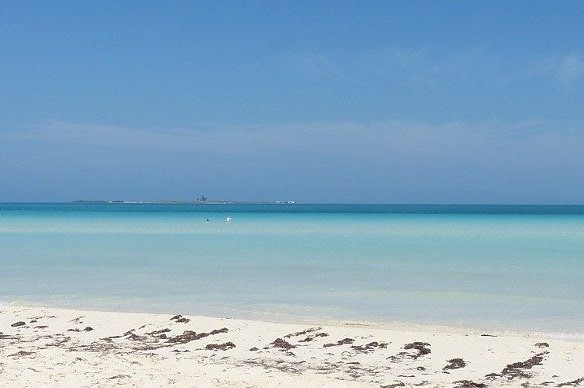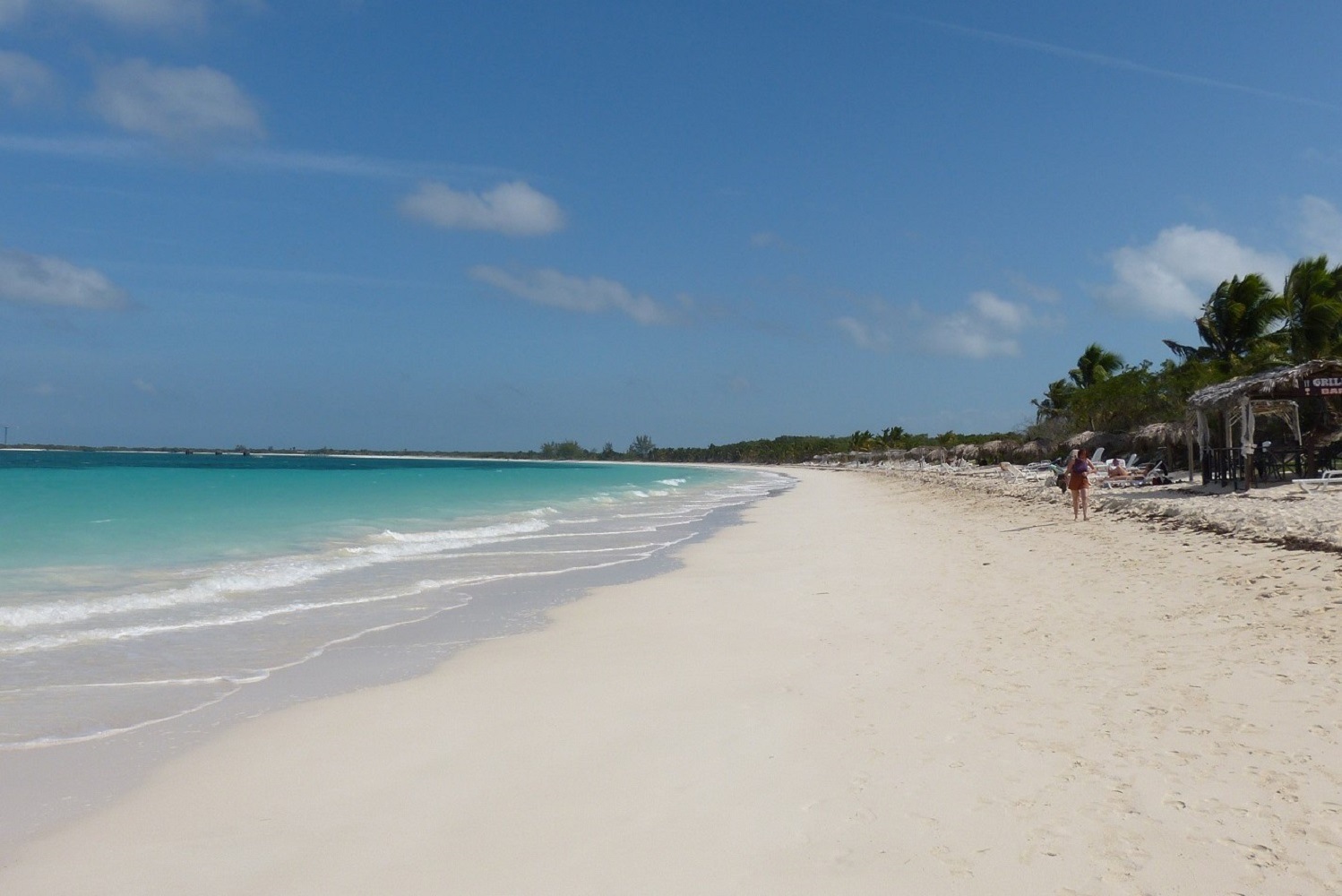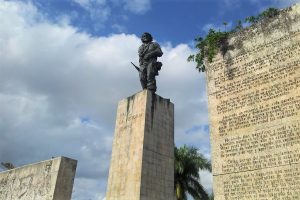Cayo Coco

Updated: Jun 22, 2021

In the center of the Cuban north coast lies the island chain of the Jardines del Rey in the Atlantic Ocean. While Cayo Coco is the most famous bathing paradise of the archipelago, the other islands also welcome visitors with snow-white dream beaches, turquoise water and perfect bathing weather all year round. This article gives an overview of all important information about Cayo Coco and the other islands of the Jardines del Rey.
The Jardines del Rey archipelago is located about 20 km east of the second array of keys known as Cayo Santa Maria. Jardines del Rey translates as the Gardens of the King, which is quite accurate considering the beauty of the archipelago. For a long time, the islands were only popular among fishermen, as the shallow waters are home to a variety of marine life. The area was not developed for tourism until the early 1990s, after the first connecting road to the main island was built in the late 1980s. However, since then, the number of hotels has grown steadily.
The archipelago should not be confused with the Jardines de la la Reina - the Gardens of the Queen - which are located in the Caribbean Sea on the opposite side of the main island of Cuba.
Not only one single cayo
In addition to the uninhabited Cayo Ramano, the archipelago includes four islands with relevance for tourism. These are the Cayo Paredón Grande, on which the first hotel has just opened, as well as the Cayo Guillermo, which has already been developed with several hotels, and of course the best known and largest island, the Cayo Coco. In addition, there is Cayo Cruz, a little further east, which was recently developed with a connecting road and three new hotels. The effort of the Cuban authorities is to create on the Cayo Cruz in the near future about 4000 hotel rooms.
All the cayos have white dream beaches with shallow crystal clear ocean shimmering in all shades of blue and turquoise. The sea is home to a varied underwater world, including impressive coral reefs full of colorful fish. The bays and lagoons are also home to many water birds, including the bizarre flamingos.
All four islands is located about 20 km in the Atlantic, surrounded by turquoise sea. There are two causeways that connect to the main island.
­
Beaches
On the archipelago of the Jardines del Rey there are more than ten sections with over 50 kilometers of paradisaical beaches. Five of the beach sections are located on the main island, Cayo Coco, three on Cayo Guillermo, two on Cayo Paredón Grande and one on Cayo Cruz.
Beaches at Cayo Coco
- The approximately three-kilometer-long Playa Flamencos is home to three bigger hotel complexes and represents one of the main beaches of Cayo Coco. Not far from the beach is also Plaza Los Flamencos, a shopping center.
- North of Playa Flamenco lies Playa Prohibida - the forbidden beach. The surroundings of the beach are undeveloped and natural except for a beach bar. The narrow beach is characterized by its sand dunes up to fifteen meters high and is wonderful for a walk.
- The Playa Larga is located on the northeast coast of Cayo Coco. The beach is with nearly 3 kilometers of length right wide and therefore is not too packed with guests. There are four hotels at Playa Larga, two of which are IBEROSTAR, one TRYP and the purely state-owned Hotel Colonial Cayo Coco. A good 500 meters from the beach is a small shopping center, the Centro Comercial La Gaviota, where handmade souvenirs, rum, coffee and of course cigars can be purchased.
- Right next to Playa Larga lies Playa Colorades, the easternmost beach on Cayo Coco. There are two Meliá hotels, a Pullman and the Sol Cayo Coco, located on the beach, which is a good two and a half kilometers in length.
- The Playa la Laula is a beautiful, very extensive beach with only two hotels, with the Memories Caribe Beach Resort being the better one.
Beaches at Cayo Guillermo
- At the far east of Cayo Guillermo you will find Playa Pilar, known as one of the most beautiful beaches in Cuba. At the beach named after Hemingway's yacht, with crystal clear water and dunes up to 15 meters in height. In a small beach bar, sunbeds with umbrellas can be lent (5 USD). In recent years, two new hotel complexes have been constructed not far from the beach, including Cuba's second Kempinski luxury hotel, which is located at the western end of the beach.
- With a length of 3.5 kilometers, the Playa del Paso is the longest beach on Cayo Guillermo. There are eight hotel complexes along the beach. At the southern end, there lies a small marina (Marina Cayo Guillermo) from which catamaran and boat excursions depart.
- Located between the beaches of Playa Pilar and Playa El Paso, is Playa del Medio, on the edges of which are two hotels. At the southeastern tip of the beach is the Gran Muthu Imperial, and to the northeast another resort has recently opened.
Cayo Paredón Grande
- More than six kilometers long Playa los Pinos is located on the east side of Cayo Paredón Grande. The beach was out of the way for a long time and was little visited, but last year a new hotel was built and others will follow soon.
- The Playa del Norte, about four kilometers long, is located on the northeast coast of Cayo Paredón Grande. The beautiful beach has been left in its natural state so far, but is planned to be developed for tourism.
On the developed part of Cayo Curz there is a about 10 kilometers long beautiful beach. There is another wonderful beach on the untouched Cayo Mégano Grande.
­
See & Do
You can book activities and guided tours through the state-run tour operators, which have small offices in the hotels.
See
- In the middle of El Baga Natural Park (map), about four kilometers south of Playa Flamenco, lies the Sitio La Güira, a traditional farmhouse. On the grounds is the Ranchon Aguada de Pedro, a restaurant with a small museum. If you want, you can also stay quite inexpensively in one of the traditional huts (see Accommodation). It is a good place for an escape out of the resort.
- At the southern tip of Caya Guillermo you will find the Laguna Flamingos, which, as the name suggests, is often home to a large number of flamingos. The lagoon with its bizarre pink birds can be observed and photographed from the side of the main road.
- In the middle of El Baga Natural Park, located about four kilometers south of Playa Flamenco, is the Sitio La Güira, a resort in the style of a traditional farmhouse. On the grounds is the Ranchon Aguada de Pedro, a restaurant that is an ideal place for an excursion. Furthermore, there is a small museum. If you want, you can also stay quite inexpensively in one of the traditional huts (details see below under accommodation).
Do
- The Rocarena Climbing Center or the Parque de Escalada is located in the east of Cayo Coco between Playa Larga and Playa Las Coloradas. On the almost 20 meters high facility can be climbed on different levels of difficulty. There is also a small climbing wall. Visitors receive professional (safety) instructions. The prices are age-dependent: Two hours of climbing costs 5 USD (up to 8), 12 USD (8 to 16), or 16 USD (16 and over). Each additional hour costs half the entrance extra. In addition, you can climb on the wall (5 USD for 15min) or also do a small bungee jump (10 USD).
- There are several jeep tours available. The longest excursion includes a visit to the delphinium, a sightseeing tour of the historic center of the city of Morón, a visit to a crocodile farm and a catamaran ride in the afternoon. The price is 150 USD per person. Another excursion includes a speedboat ride and a visit to Loma de Cunagua (100 USD).
- Just two kilometers off Playa Pilar lies the small Cayo Media Luna in the Atlantic Ocean. The Cuban ex-dictator Batista had a summer residence on this little island. The Cayo also appears in Hemingway's novel. It can be assumed, that the famous writer is fished there. Today there is a restaurant located in the one and only building. In addition, there are also several beaches that invite visitors to swim and snorkel.
On & under the water
- The dive center Blue Diving is located directly on the beach of the Melia Cayo Coco Hotel on Cayo Guillermo. At least twice a day, a boat departs to one of the sensational 13 dive sites. During a dive one can expect to see tropical fish and corals, and with a little luck you may also encounter rays, turtles or nurse sharks. The first dive costs 45 USD. The more you dive, the cheaper it gets: 10 dives will cost you 315 USD. Beginners can also take certified courses. Paying for the dives with credit cards is also possible.
- On Cayo Coco, near the Hotel Iberostar Mojito, you will find a kite school at the beach, where you can rent equipment or participate in courses. The school has a website where you can find offers and prices.
- Starting from Marina Gaviota, several catamaran excursions are offered. During the trip, you have several opportunities to swim and snorkel in the paradisiacal waters. Stops are made at a shallow sandbank. Equipment, drinks (including beer, rum & cocktails). Lunch and air-conditioned transfer from the hotel are included. The excursion is about eight hours and the price is 80 USD per person.
Excursions
- The Laguna de La Leche () is located just a little north of the small town of Morón. The name ("Milky Lagoon") is due to the whitish color of the water, caused by the high content of limestone in the water. The lake is the largest natural freshwater reservoir in Cuba. There are many fish in the lake, so it is popular with anglers and flamingos alike. On the southern shore, there is a restaurant and bar that are located on stilts above the water. There is also the possibility of boat trips.
- The Parque Nacional Caguanes is an excursion destination for nature lovers. The park is especially known for different cave systems and its very interesting flora and fauna. The most famous cave is the Cueva Grande - the big cave. In the area it is possible to hike and observe birds (pelicans, flamingos & tocororos). Guided excursions to the national park can be booked at Ecotur. Offices of the stat-run tour agency can be found on Cayo Coco at Hotel Sol as well as in the town of Morón.
- From the observation deck of the Loma de Cunagua (), which is over 300 meters in height, one has a wonderful panoramic view of the northern part of the province of Ciego de Ávila.
- Further destinations are the cities of Sancti Spiritus, Camagüey and Trinidad. A great treasure of breathtaking nature offers the Sierra del Escrambray.
­
Transport
Getting around
- A modern sightseeing bus (Jardines del Rey Bus Tour) operates during the day between the hotels, beaches and sights along the various cayos. The buses run from 8 am to 4 pm. The times are indicated at the bus stops in front of the hotels and other stops. The price of the tickets is 5 USD per person per day. The route runs from the far west (Playa Pilar) to the Aparthotel Islazul Azul. Since the buses are open at the top, you should not forget the sunscreen essential for Cuba. If you want to take the last bus in the late afternoon, you have to expect that it can get very packed.
- Modern state cabs are waiting in front of the hotel facilities. Alternatively, you can take one of the old-timer cabs, which are only slightly more expensive. Cabs can also be ordered in hotels at the reception. In the case of airport transfers, one should make reservations in advance.
Getting there & Excursions
- Rental cars can also be reserved on all cayos. Those who only want to take a small tour also have the option of renting scooters. There are 50cc and 125cc to choose from, with prices starting at 25 USD per day. Bicycles can also be rented at some hotels (5 USD / day). All information about renting and driving vehicles can be found in the article about rental cars.
- Those arriving by airplane will pass by the small airport on Cayo Coco (Jardines del Rey Airport). Domestic flights to and from Havana are also operated from this airport. Depending on the location of the hotel, the transfer from the airport can take up to an hour.
­
Accommodation
On the Cayos there are exclusively larger hotel resorts, almost all of which fall into the five-star luxury segment. In recent years, new hotels have been built continuously. Nevertheless, the number of vacationers remains relatively manageable. Most of the hotels are managed by international chains. Among the chains are IBEROSTAR, Meliá and Kempinski. The only alternative to a hotel is the Sitio La Güira, where travelers can stay in inexpensive (simple) cabins.
Cayo Guillermo is currently home to ten hotels on three stretches of beach. The most exclusive resort, the Kempinski Resort, is located at the end of Playa Pilar, at the western tip of the island. At the other end of the beach is the IBEROSTAR Playa Pilar. In the middle of the cayo, two resorts share a 600-meter beach, Playa del Medio. The remaining six hotels are located at the eastern end of the cayo, along the longest section of beach, Playa El Paseo, which is a good 3.5 kilometers long.
­





